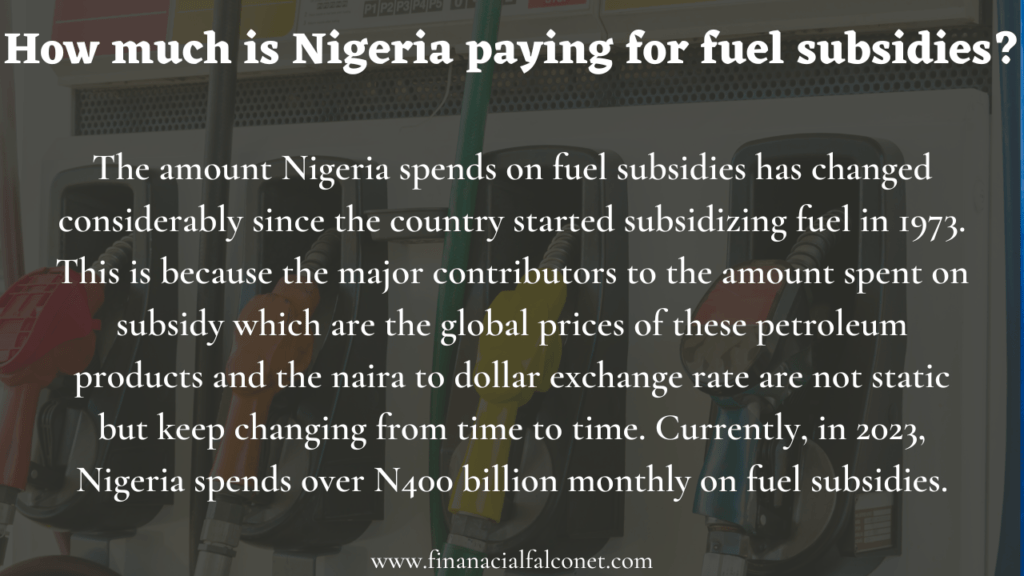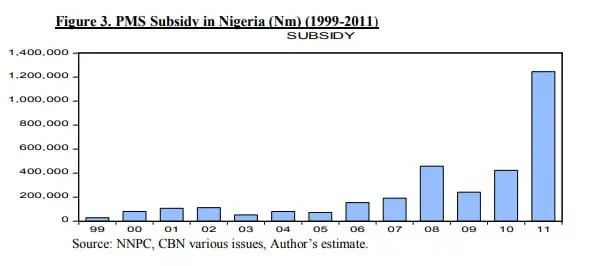How much is Nigeria paying for fuel subsidy? For decades, Nigeria has maintained a fuel subsidy program that provides a government-controlled price for petrol (gasoline) and other refined petroleum products, often at a rate below the cost of production. The intention of the program was to ensure that the nation’s citizens, particularly the poor, have access to affordable fuel. However, over the years, the subsidy program has become a source of controversy, with some experts questioning its effectiveness and efficiency in achieving its intended objectives.
This is due to the high costs associated with the subsidy, which have led to significant economic challenges, including large budget deficits and increasing dependence on imported refined products. In this article, we shall discuss how much Nigeria has spent and is still spending on fuel subsidy but before then, let us have a brief look at the meaning of fuel subsidy.
See also: Why is there fuel subsidy in Nigeria?
What is fuel subsidy in Nigeria?
Fuel subsidy in Nigeria is a government program that provides a fixed, lower price for premium motor spirit PMS (petrol) and other refined petroleum products such as kerosene, diesel, and aviation fuel. The subsidy program was introduced in 1973 as a temporary way to cushion the impact of high fuel prices on the country’s citizens, especially the poor, who heavily rely on these products for transportation, cooking, and other basic needs. This was meant to last for only 6 months but has now been in existence for 50 years.
The subsidy paid on petroleum products is the difference between the expected open market price (EOMP) and the retail price. The expected market price is the sum of the cost of the imported product, freight costs, and distributor margins. Hence the global prices of these petroleum products as well as the naira to dollar exchange rate are significant determinants of how much Nigeria spends on subsidy daily. Under the subsidy program, the Nigerian government sets a maximum price for PMS and other petroleum products, which is typically lower than the market price, and compensates oil marketers for the difference between the market price and the government-set price.
This means that the government pays a certain amount to cover the cost of importing or refining petroleum products so that the final price consumers pay is lower than the actual market price. The fuel subsidy program has been a major source of controversy in Nigeria, with some experts arguing that it is inefficient, costly, and prone to corruption. The subsidy payments have led to significant budget deficits and a growing dependence on imported refined products, which has put pressure on the country’s foreign exchange reserves.
Despite these challenges, the Nigerian government has hesitated to eliminate or significantly reduce the subsidy, given its potential impact on the country’s fragile economy and the possible social unrest that may result from such a move. There have been attempts over the years to remove fuel subsidies; these attempts have been in 1978, 1993, 2003, 2012, 2016, 2020, and 2023.
The subsidy for diesel (automotive gas oil AGO) and kerosine (national household kerosine NHK) were successfully removed in 2004 and 2016 respectively and the supply of both products stabilized over market-determined prices. However, the impact on the amount spent on fuel subsidy in Nigeria has been minimal as both products account for only a fraction of the amount spent on subsidy.
See also: Disadvantages of Fuel Subsidy Removal in Nigeria
How much is Nigeria paying for fuel subsidy?
The amount Nigeria spends on fuel subsidies has changed considerably since the country started subsidizing fuel in 1973. This is because the major contributors to the amount spent on subsidy which are the global prices of these petroleum products and the naira to dollar exchange rate are not static but keep changing from time to time. Currently, in 2023, Nigeria spends over N400 billion monthly on fuel subsidies. Based on available data over N20 trillion has been spent by Nigeria on fuel subsidy between 1973 to 2023.
Due to the lack of adequate data on the exact amount of fuel consumption in Nigeria, we will consider aggregate reports. Ismail Soile and Xiaoyi Mu in their research reported that when the subsidy policy commenced in 1973, the government provided a subsidy of 35.7% by fixing the prices of crude oil at $1.93 per barrel in the domestic market whereas the international price of crude oil was $3.00 per barrel at that time. By 1978, when the international price of crude oil was $14.10 per barrel, the government sold to domestic refineries at $13.80 per barrel.

This price was maintained even when crude oil price rose to $40 per barrel in 1980, this meant the subsidy element was amplified to 65.5%. When the export price of crude crashed to $15.11 per barrel in 1988, the price of crude to local refineries dropped to $2.0 per barrel making the subsidy element increase to 86.8%. Thus the amount spent on fuel subsidy by Nigeria in the 1980s has been pegged at about N1 billion annually. In 2000, the then Nigerian President, Olusegun Obasanjo asserted that it cost the government $2 billion to subsidize fuel annually. The subsidy for 2004 was $8 billion.
Data computed by the Nigeria Extractive Industries Transparency Initiative (NEITI) and presented to the House of Representatives on September 8, 2022, revealed that N13.697 trillion has been spent on fuel subsidies between 2005 to 2021. N4.39 trillion was spent for subsidy in 2022, and N3.36 trillion has been budgeted for fuel subsidy for January to June 2023 after which the government had earlier proposed to stop the fuel subsidy.
Nigeria’s fuel subsidy spending
The table below captures the amount spent by Nigeria annually for fuel subsidy, it should be noted that although fuel subsidy payments began in 1973, only the years with available data have been captured in this table.
| Year | Subsidy amount in Naira |
|---|---|
| 1980s | 1 billion |
| 2000 | 2 billion |
| 2004 | 8 billion |
| 2005 | 351 billion |
| 2006 | 257 billion |
| 2007 | 272 billion |
| 2008 | 631 billion |
| 2009 | 469 billion |
| 2010 | 667 billion |
| 2011 | 2.11 trillion |
| 2012 | 1.36 trillion |
| 2013 | 1.32 trillion |
| 2014 | 1.22 trillion |
| 2015 | 654 billion |
| 2016 | 240 billion |
| 2017 | 154 billion |
| 2018 | 1.19 trillion |
| 2019 | 508 billion |
| 2020 | 864 billion |
| 2021 | 1.43 trillion |
| 2022 | 4 trillion |
| 2023 (January – June) | 3.36 trillion |
See also: What is Excess Crude Account (ECA)?

Conclusion
How much is Nigeria paying for fuel subsidy? The amount Nigeria spends on fuel subsidies depends on the global price of petroleum products and the naira-to-dollar exchange rate which keeps changing yearly. In 2023, N400 billion is spent monthly. Although the subsidy for diesel and kerosine has been removed, in 2004 and 2016 respectively, a large amount is still spent on subsidies yearly because petrol accounts for more than 75% of petroleum products consumed in the country.
It is important to note that although fuel subsidies are intended to promote economic development, political stability, and social welfare. They can be unsustainable, especially when the cost of subsidies becomes too high, as it has been in Nigeria in recent years.
There have also been concerns about corruption leading to siphoning of subsidy funds and the inordinate distribution of benefits. In view of these, alternative policies and strategies should be implemented to promote economic development, such as investments in infrastructure and human capital development.
The debate around subsidy removal remains a contentious issue, with proponents arguing for the need to redirect funds to other social programs. In contrast, others call for the continuation of subsidies to protect the welfare of low-income households.
Last Updated on November 2, 2023 by Nansel Nanzip BongdapBlessing's experience lies in business, finance, literature, and marketing. She enjoys writing or editing in these fields, reflecting her experiences and expertise in all the content that she writes.
